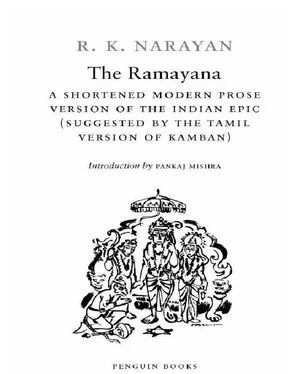Махариши Вальмики - The Ramayana
Здесь есть возможность читать онлайн «Махариши Вальмики - The Ramayana» весь текст электронной книги совершенно бесплатно (целиком полную версию без сокращений). В некоторых случаях можно слушать аудио, скачать через торрент в формате fb2 и присутствует краткое содержание. Жанр: Старинная литература, на английском языке. Описание произведения, (предисловие) а так же отзывы посетителей доступны на портале библиотеки ЛибКат.
- Название:The Ramayana
- Автор:
- Жанр:
- Год:неизвестен
- ISBN:нет данных
- Рейтинг книги:3 / 5. Голосов: 1
-
Избранное:Добавить в избранное
- Отзывы:
-
Ваша оценка:
- 60
- 1
- 2
- 3
- 4
- 5
The Ramayana: краткое содержание, описание и аннотация
Предлагаем к чтению аннотацию, описание, краткое содержание или предисловие (зависит от того, что написал сам автор книги «The Ramayana»). Если вы не нашли необходимую информацию о книге — напишите в комментариях, мы постараемся отыскать её.
The Ramayana — читать онлайн бесплатно полную книгу (весь текст) целиком
Ниже представлен текст книги, разбитый по страницам. Система сохранения места последней прочитанной страницы, позволяет с удобством читать онлайн бесплатно книгу «The Ramayana», без необходимости каждый раз заново искать на чём Вы остановились. Поставьте закладку, и сможете в любой момент перейти на страницу, на которой закончили чтение.
Интервал:
Закладка:
There is really no Western counterpart in either the Hellenic or Hebraic tradition to the influence that this originally secular story, transmitted orally through many centuries, has exerted over millions of people. The Iliad and The Odyssey are, primarily, literary texts, but not even Aesop’s fables or the often intensely moral Greek myths shape the daily lives of present-day inhabitants of Greece. In contrast, The Ramayana continues to have a profound emotional and psychological resonance for Indians.
By invoking the utopian promise of Rama-Rajya (kingdom of Rama), Gandhi attracted a large mass of apolitical people to the Indian freedom movement against the British. Postcolonial India may not resemble Rama-Rajya, but the emotive appeal of Ramayana seems to be undiminished, and often vulnerable to political exploitation: in the late eighties and early nineties, the Hindu nationalist movement to build a temple on the alleged birthplace of Rama claimed thousands of lives across India.
Like millions of other children, I first heard the story of Rama from my parents. Or so I think: I can’t remember a time when I did not know it. Religious occasions at home began with a recital of the Ramacharitamanas , the long sixteenth-century devotional poem based on the story of Rama. All the older people I knew were only two or three decades away from village life, and they had memorized the verses in their childhood. I remember my elder sisters arguing with them about just how righteous Rama was when he killed a monkey king in cold blood or forced his wife, Sita, to undergo a test of chastity after her return from captivity.
Every autumn, I looked forward to Diwali, the most important Indian festival, which commemorates Rama’s return from exile, and which children in particular love since it gives them an opportunity to buy new clothes and firecrackers and eat sweets. Autumn was also the time of the Ramleela , the folk pageant-play based on Rama’s adventures, which is performed even today in not only all North Indian small towns and cities but also in the remote Fiji Islands and Trinidad, where descendents of nineteenth-century Indian immigrants try to hold on to their cultural links with their mother country.
I remember the performers with bare torsos, walking in an exaggerated, mincing style on their toes; Hanuman “flying” across the stage on a transparent wire; and, at the end of ten days, the burning of the big ten-headed tinsel effigy of Ravana. Armed with a bamboo bow and arrow, I imagined myself to be Rama, pursuing the forces of disorder. But it was only later I realized that though there is much of the fairytale in The Ramayana to engage the child—the prince thrown upon fate, the kidnapped princess, flying monkeys—it also has a complex adult and human aspect. Far from representing a straightforward battle between good and evil, it raises uncomfortable ethical and psychological questions about human motivation; it shows how greed and desire rule human beings and often make them arrogant and prone to self-deception. Even the idealized figure of Rama hints paradoxically at the difficulty of leading an ethical life.
Most versions of Rama’s story begin with Dasaratha, the heir-less king of Kosala who, on the urging of his spiritual advisors, performs a sacrificial ritual that enables his three wives to conceive sons. The firstborn, Rama, is the ablest and most popular of Dasaratha’s offspring, who proves his superiority by stringing an enormous bow others can barely lift and by winning his bride, Sita.
When Dasaratha decides to retire from worldly duties, he chooses Rama as his successor. This greatly dismays his second wife, who wants her own son to be king. Just as the coronation of Rama is about to begin, she asks her husband to redeem two boons he had once made to her at a weak moment in his life. She demands that Rama be banished from Ayodhya for fourteen years and her son be anointed king in his place.
Dasaratha is deeply distraught by this unreasonable demand. But he is unable to refuse her—to keep one’s vow is deemed one of the highest moral achievements in The Ramayana . Similarly, it is part of Rama’s virtue to be obedient to and unquestioning of his parents. He accepts his father’s decision and, accompanied by his wife, Sita, and half-brother Lakshmana, he abandons Ayodhya, much to the grief of its inhabitants.
Traveling through forests, Rama and his companions have many adventures. But none proves more dramatic than Rama’s encounter one day with a demoness called Soorpanaka. She falls in love with Rama and proposes marriage to him, and then concludes that Sita’s great beauty is to blame for his indifference to her. When she tries to attack Sita, Lakshmana mutilates her. Soopanaka flees to her brother Ravana, the all-powerful demon king of the island of Lanka, and tells him of the cruelty inflicted upon her.
The accounts of Sita’s beauty stir Ravana’s curiosity and desire. He arranges for a distraction that draws Rama and Lakshmana away from her hermitage. Then, dressed as a holy man, Ravana manages to enter Sita’s dwelling and kidnaps her.
Now begins Rama’s pursuit of Ravana, which leads him to unexpected friends and allies in a monkey kingdom. His most devout monkey ally, Hanuman, crosses the ocean to Lanka and alerts Sita that help is on the way. Hanuman also allows himself to be captured and produced in Ravana’s court. Ravana disregards his warning of impending doom at the hands of Rama and orders Hanuman’s tail to be set alight. But Hanuman escapes and, in the process, sets all of Lanka on fire. On his return, he helps Rama plan for the inevitable assault on Lanka, which comes after the monkey army builds a bridge over the ocean to the island.
After a long and bloody battle, Rama kills Ravana and his closest associates. But he suspects that Sita’s virtue has not survived her long confinement in Lanka and refuses to accept her. A distraught Sita undergoes a trial by fire in order to prove her chastity, and survives. A chastened Rama returns with her to Ayodhya to be crowned king. But doubts about Sita’s virtue haunt him and when he hears of rumors against her among the general public he banishes her from his kingdom. In exile she gives birth to two sons. Not long after this, she passes away, and a bereft and heartbroken Rama decides to join her in heaven.
This is the basic story on which many variations have been made through the centuries. It is not clear when it first came into being: bardic literature that has been orally transmitted cannot be precisely dated. Moreover, the story of Rama has proliferated bewilderingly across India and Southeast Asia. It exists in all major Indian languages, as well as Thai, Tibetan, Laotian, Malaysian, Chinese, Cambodian, and Javanese. In places as remote from India as Vietnam and Bali, it has been represented in countless textual and oral forms, sculpture, bas-reliefs, plays, dance-drama, and puppet plays.
Little is known about the poet Valmiki, who apparently wrote the first narrative in Sanskrit, probably around the beginning of the Christian era. Many Indians consider Valmiki’s Ramayana to be the standard version, and it is still presented as such in many translations into English. But its version of Rama’s story has been repeatedly challenged, repudiated, or simply ignored in multiple artistic forms that originate not so much from an ur-text as from what the Indian poet and critic A. K. Ramanujan called an “endemic pool of signifiers (like a gene pool).” 1
Valmiki presented an idealized, if not beatified, image of Rama, establishing the basis for his popular reverence. Later versions present Rama as an incarnation of Lord Vishnu, the principal Hindu deity who helps preserve moral order in the world, giving epic literature a sacred dimension, and helping make The Ramayana part of the cult of Vishnu, one of the major cults of popular Hinduism. But many of these versions, reflecting as they do the social diversity of India, contradict one another, often self-consciously. In the version preferred by Jains, an Indian sect organized around the principles of asceticism, Ravana is a sympathetic character, and Rama and Sita end up as world-renouncing monk and nun, respectively. The devotional rasik tradition in North India focuses on the marriage of Rama and Sita and ignores most of the events before and after it. The nineteenth-century Anglicized Bengali writer Michael Madhusudan Dutt chose to exalt Ravana over Rama in a long narrative poem. Ravana remains one of the heroes of low-caste Dalits in Maharashtra.
Читать дальшеИнтервал:
Закладка:
Похожие книги на «The Ramayana»
Представляем Вашему вниманию похожие книги на «The Ramayana» списком для выбора. Мы отобрали схожую по названию и смыслу литературу в надежде предоставить читателям больше вариантов отыскать новые, интересные, ещё непрочитанные произведения.
Обсуждение, отзывы о книге «The Ramayana» и просто собственные мнения читателей. Оставьте ваши комментарии, напишите, что Вы думаете о произведении, его смысле или главных героях. Укажите что конкретно понравилось, а что нет, и почему Вы так считаете.












